Submitted by chandra on Mon, 2017-06-26 15:45
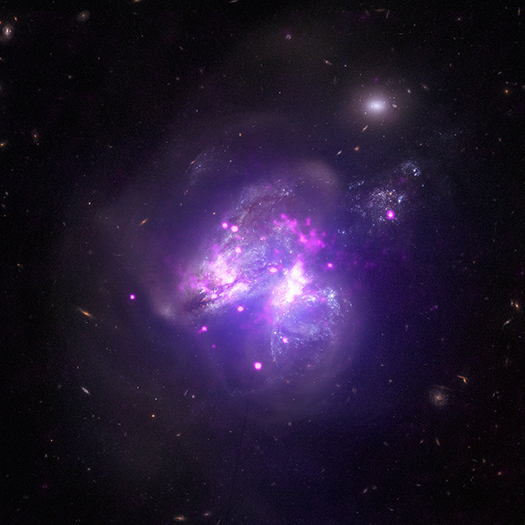
What would happen if you took two galaxies and mixed them together over millions of years? A new image including data from NASA's X-ray Observatory reveals the cosmic culinary outcome.
Arp 299 is a system located about 140 million light years from Earth. It contains two galaxies that are merging, creating a partially blended mix of stars from each galaxy in the process.
However, this stellar mix is not the only ingredient. New data from Chandra reveals 25 bright X-ray sources sprinkled throughout the Arp 299 concoction. Fourteen of these sources are such strong emitters of X-rays that astronomers categorize them as "ultra-luminous X-ray sources," or ULXs.
These ULXs are found embedded in regions where stars are currently forming at a rapid rate. Most likely, the ULXs are binary systems where a neutron star or black hole is pulling matter away from a companion star that is much more massive than the Sun. These double star systems are called high-mass X-ray binaries.
Submitted by chandra on Wed, 2016-11-09 12:51
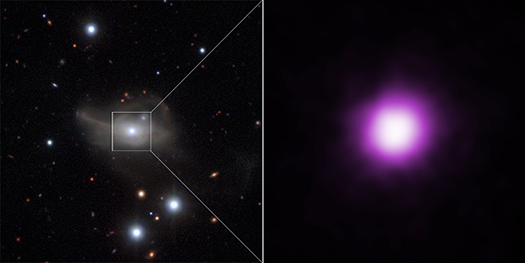
Astronomers may have solved the mystery of the peculiar volatile behavior of a supermassive black hole at the center of a galaxy. Combined data from NASA's Chandra X-ray Observatory and other observatories suggest that the black hole is no longer being fed enough fuel to make its surroundings shine brightly.
Submitted by chandra on Tue, 2016-10-18 11:09
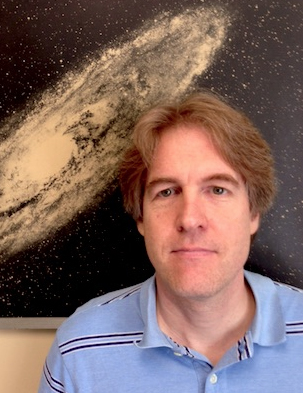 Jimmy Irwin
Jimmy IrwinWe are pleased to welcome Jimmy Irwin as our guest blogger today. Jimmy is the first author of a new Nature paper describing the detection of two mysterious, flaring X-ray sources in Chandra data. Irwin is an associate professor at the University of Alabama. After obtaining his PhD from the University of Virginia, he was a postdoc, a Chandra Fellow, and a research scientist at the University of Michigan. He studies the X-ray binary and hot gas content of galaxies, as well as the hot intracluster medium of groups and clusters of galaxies.
Projects don't always turn out the way one expects them to. Sometimes the result is uninteresting, but other times they far exceed expectations. Our project began as an undergraduate endeavor for two students looking to work on a project for college credit. A third student, who was a friend of one of the students, joined the project just for fun.
Submitted by chandra on Tue, 2016-08-09 12:23
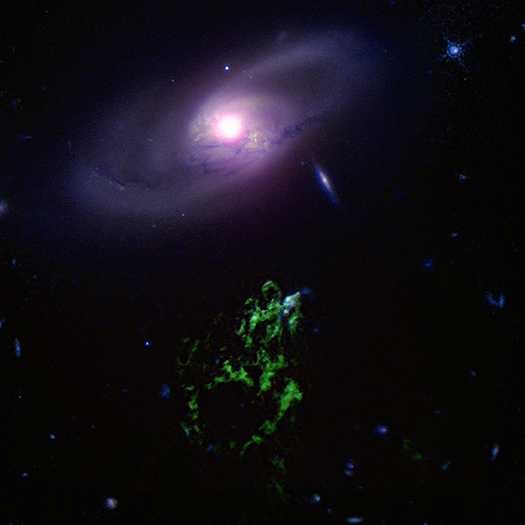
Two cosmic structures show evidence for a remarkable change in behavior of a supermassive black hole in a distant galaxy. Using data from NASA’s Chandra X-ray Observatory and other telescopes, astronomers are piecing together clues from a cosmic “blob” and a gas bubble that could be a new way to probe the past activity of a giant black hole and its effect on its host galaxy.
Submitted by chandra on Tue, 2016-02-16 13:08
 Aurora Simionescu
Aurora SimionescuWe are pleased to welcome a guest blogger, Aurora Simionescu, who led the study that is the subject of our latest press release, about a distant X-ray jet. Originally from Romania, Aurora completed her PhD at the Max Planck Institute for Extraterrestrial Physics in Garching, Germany, before moving to Stanford University as an Einstein Postdoctoral Research Fellow. She is currently working as an International Top Young Fellow at the Institute of Space and Astronautical Sciences of the Japan Aerospace Exploration Agency. Besides being a high-energy astrophysicist, she is also a part-time travel and nature photographer with a skiing addiction who loves ballroom dancing and the color pink.
Around March 2014, my colleague, Lukasz Stawarz, who was then sharing an office with me at the Japan Aerospace Exploration Agency, showed me a very odd astronomical object he and his collaborators had found by searching though archived radio observations from the Very Large Array (VLA).
Submitted by chandra on Tue, 2016-02-16 10:00
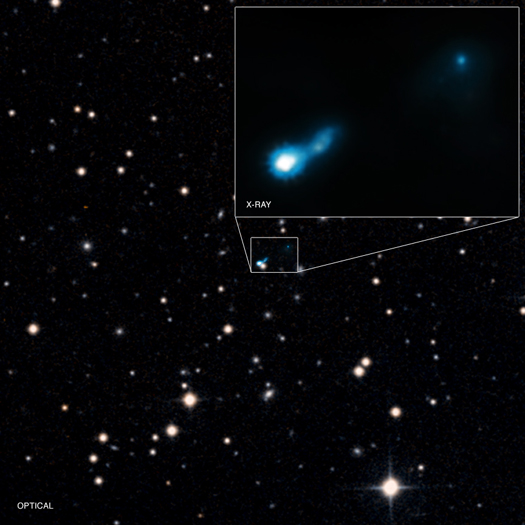
A jet from a very distant black hole being illuminated by the leftover glow from the Big Bang, known as the cosmic microwave background (CMB), has been found as described in our latest press release. Astronomers using NASA's Chandra X-ray Observatory discovered this faraway jet serendipitously when looking at another source in Chandra's field of view.
Submitted by chandra on Tue, 2016-02-02 09:14
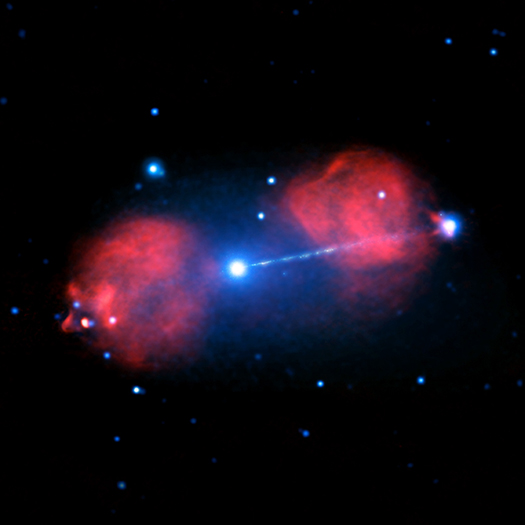
The Star Wars franchise has featured the fictitious "Death Star," which can shoot powerful beams of radiation across space. The Universe, however, produces phenomena that often surpass what science fiction can conjure.
The Pictor A galaxy is one such impressive object. This galaxy, located nearly 500 million light years from Earth, contains a supermassive black hole at its center. A huge amount of gravitational energy is released as material swirls towards the event horizon, the point of no return for infalling material. This energy produces an enormous beam, or jet, of particles traveling at nearly the speed of light into intergalactic space.
Submitted by chandra on Tue, 2015-08-11 10:26
 Vivienne Baldassare
Vivienne BaldassareWe are very pleased to welcome Vivienne Baldassare as a guest blogger today. Vivienne is the first author of a paper that is the subject of our latest press release, about an exceptionally small supermassive black hole. She is a PhD candidate and National Science Foundation Graduate Research Fellow in the University of Michigan Department of Astronomy. Vivienne obtained her undergraduate degree in physics from Hunter College, where she was also a member of the Macaulay Honors College.
It is well established that most, if not all, massive galaxies host supermassive black holes at their centers − our own Milky Way houses a several million solar mass black hole in its core. Little is known, however, about the population of black holes in the centers of dwarf galaxies. I study the centers of small galaxies to see how many host supermassive black holes and if those black holes interact with their galaxies in the same way as bigger supermassive black holes.
Though dwarf galaxies are more common than large galaxies, it is more difficult to determine whether they host black holes. When galaxies are large and nearby, we can find central black holes by studying the motions of stars in the region dominated by the gravity of the black hole. Since smaller black holes influence smaller regions, this method would only work for dwarf galaxies in our cosmological back yard. Instead, we must search for active black holes in dwarf galaxies, i.e. black holes that are voraciously consuming material, releasing large amounts of light from the galaxy’s center.
Submitted by chandra on Tue, 2015-08-11 10:16
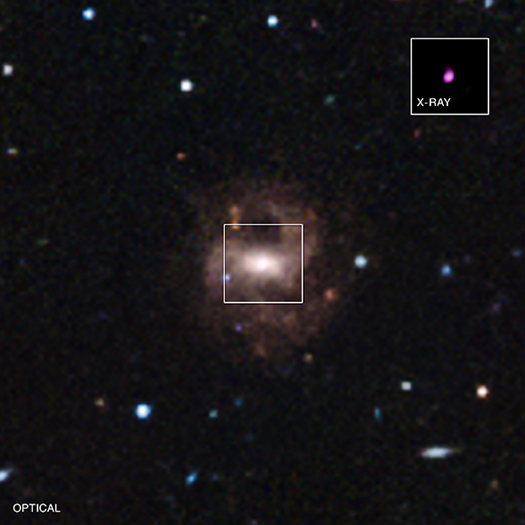
Astronomers using NASA's Chandra X-ray Observatory and the 6.5-meter Clay Telescope in Chile have identified the smallest supermassive black hole ever detected in the center of a galaxy, as described in our latest press release. This oxymoronic object could provide clues to how much larger black holes formed along with their host galaxies 13 billion years or more in the past.
Submitted by chandra on Thu, 2015-05-28 09:55
 Eric Perlman
Eric PerlmanWe are very pleased to welcome Eric Perlman as a guest blogger today. He led the study setting limits on the foaminess of space-time that is the subject of our latest press release. Eric is a professor at the Florida Institute of Technology. After completing his PhD in 1994 at the University of Colorado, he held postdoctoral fellowships at the Goddard Space Flight Center and Space Telescope Science Institute. He also held research positions at Johns Hopkins University and the University of Maryland, Baltimore County. He has lived in Florida for 8 years and enjoys his family, singing, and playing chess and other board games.
Astronomy has been a tool of discovery since the dawn of civilization. For thousands of years, humans used the stars to navigate and find their place in the universe. Astronomy made possible the travels of the ancient Polynesians across the Pacific Ocean as well as measurements of the Earth’s size and shape by the ancient Greeks. Today, astronomers search for hints about what the universe was like when the universe was much younger. So imagine, for a second, what life would be like – and how much less we would know about ourselves and the universe – if the microscopic nature of space-time made some of these measurements impossible.
Pages